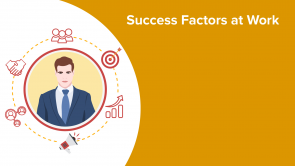Learning at work (part 2): learning processes

Über den Vortrag
Der Vortrag „Learning at work (part 2): learning processes“ von Michael Schmitz ist Bestandteil des Kurses „Success Factors at Work“. Der Vortrag ist dabei in folgende Kapitel unterteilt:
- Neuroscience: Making connections
- Short-term memory: 101010
- Sport: The decision maker
- Long term: Call 116
- Sleep: The magic pill
- The Power of Sleep: 90 Minutes
- S1: Initiate recovery
- S2: Repair motoric skills
- S3&4: Clean-up and beauty work
- REM: Long term skills and thinking
Quiz zum Vortrag
Connections between neurons and the make-up of the neurons themselves define our thought processes. What is not correct?
- Connections between Neurons start with Wave speed (15m/s) and can be upgraded to Saltatory speed (up to 40+ m/s).
- Connections between Neurons start with Wave speed (5m/s) and can be upgraded to Saltatory speed (up to 50+ m/s).
- Connections between Neurons start with Wave speed (10m/s) and can be upgraded to Saltatory speed (up to 60+ m/s).
- Connections between Neurons always work with the same speed.
101010 ...
- describes a learning rule that helps us to connect neurons with each other, using the chemical connection process very efficiently.
- describes the way information is stored inside our brain.
- explains how to connect various neurons, by using the chemical process in the fastest possible way.
- is a learning rule for our long term memory.
What do we not need to do to learn faster and remember more?
- Sleep enough.
- Create connections between neurons, and then upgrade them.
- Use the technique 101010.
- Repeat tasks again and again.
What does Dial 116 imply?
- By revising a material after 1 day, 1 week and 6 weeks, connection processes are initiated, additional connectors are grown and connections are made permanent.
- By revising a material after 1 day, 1 week and 6 weeks, connection processes are initiated, additional connectors are grown and connections are made temporary.
- By revising a material after 1 week, 1 month and 6 months, connection processes are initiated, additional connectors are grown and connections are made permanent.
- By revising a material after 1 day, 1 week and 6 weeks, connectors get lost.
Our long-term memory ...
- is created through Myelin and a process called LTP.
- depends only on the amount of time we have spent training or in lectures.
- is fairly complex to understand, but Myelin and 117 will help.
- is unchangeable and almost perfect once established with 116.
Sleep is a powerful tool that needs to be correctly understood to improve our performance. Sleep phases ...
- form cycles of around 90 minutes, which repair our brain.
- are short and can be trained to be performed faster.
- form cycles that should result in about 8 hours of sleep each night.
- are difficult to understand and have very little impact on our performance.
Diese Kurse könnten Sie interessieren
Kundenrezensionen
5,0 von 5 Sternen
| 5 Sterne |
|
5 |
| 4 Sterne |
|
0 |
| 3 Sterne |
|
0 |
| 2 Sterne |
|
0 |
| 1 Stern |
|
0 |



